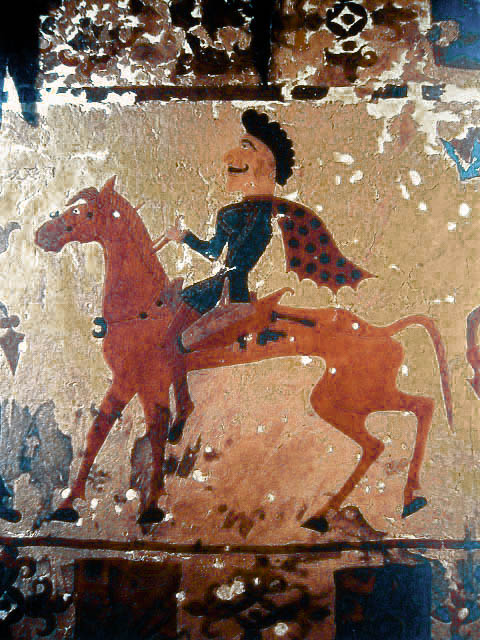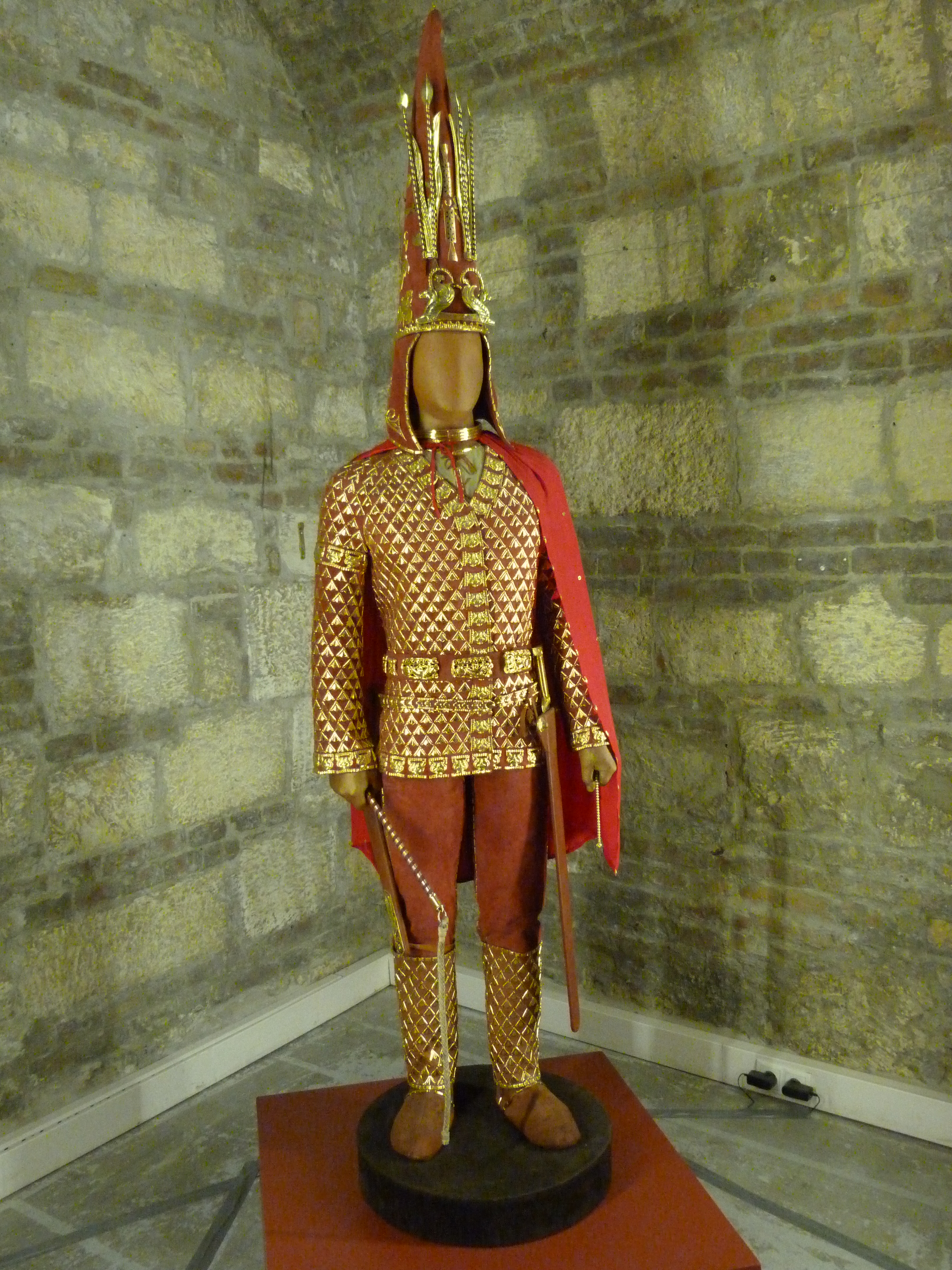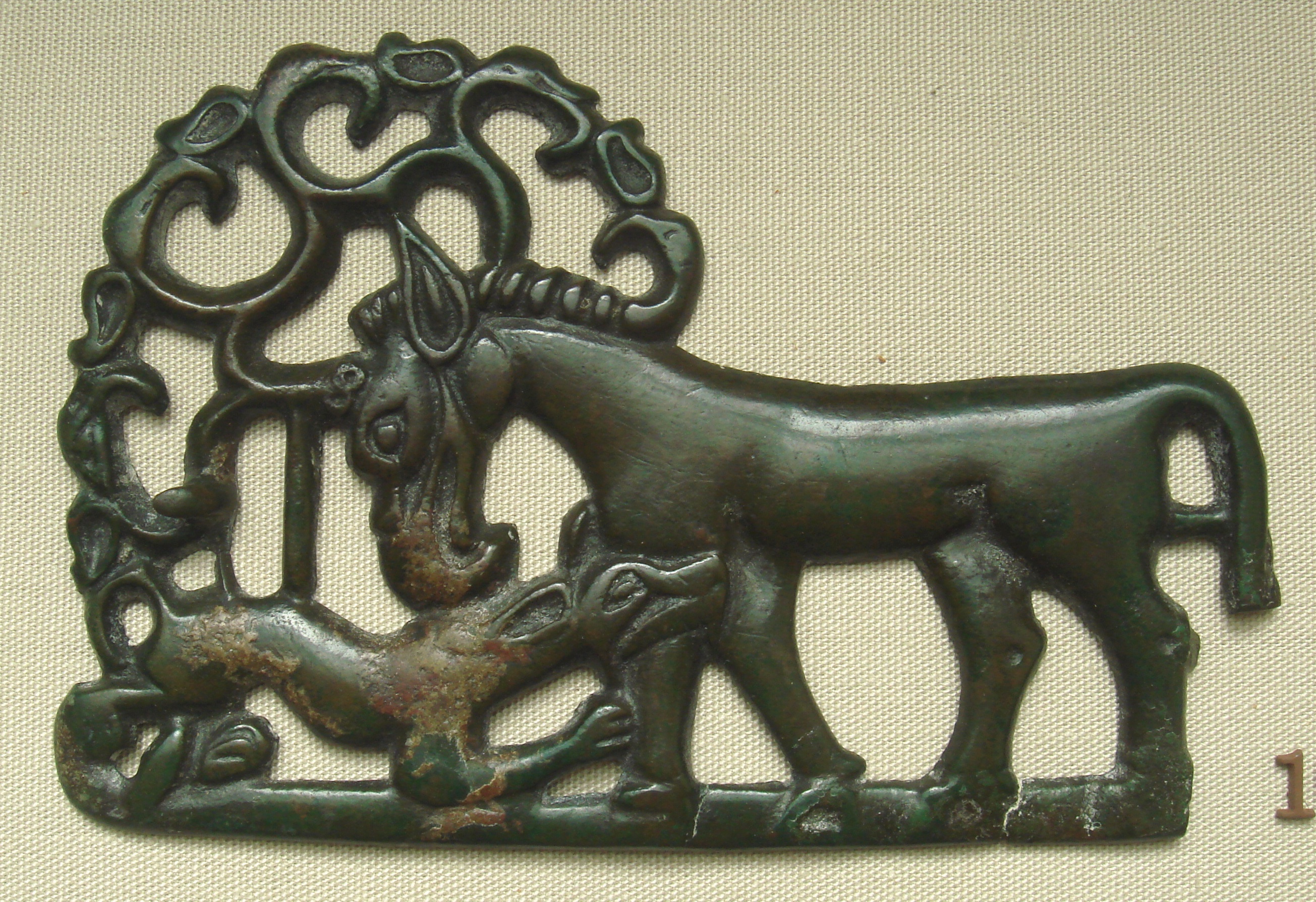스키타이 문화
"오늘의AI위키"의 AI를 통해 더욱 풍부하고 폭넓은 지식 경험을 누리세요.
1. 개요
스키타이 문화는 기원전 1천년 초 유라시아 대초원에서 시작되어 동서로 확장된 문화로, 기원과 확산, 유전적 기원, 민족 구성, 특징 등을 포함한다. 스키토-시베리아 세계는 승마, 동물 양식 예술, 스키타이 삼위일체로 알려진 특징을 보이며, 다양한 민족 집단으로 구성되었다. 유전학 연구에 따르면 동부와 서부 스키타이인은 부계 계통에서 뚜렷한 차이를 보였고, 모계 계통은 동서 유라시아의 혼합을 나타냈다.
더 읽어볼만한 페이지
- 아시아의 철기 문화 - 판석묘 문화
판석묘 문화는 기원전 1300년경 자바이칼에서 시작하여 몽골, 중국 북부, 만주 등지에 분포하며, 판석으로 둘러싸인 무덤 형태를 특징으로 하는 청동기 및 초기 철기 시대의 고고학 문화이다. - 아시아의 철기 문화 - 사후인 문화
사후인 문화는 기원전 771년부터 기원전 221년까지 동남아시아에 존재했던 고대 문화로, 철기 유물과 항아리 매장, 링링오 옥 장신구, 광범위한 무역 네트워크가 특징이다. - 스키티아 - 아마조네스
아마조네스는 고대 그리스 신화에 등장하는 여성 전사 부족으로, 트로이아 전쟁 시기 흑해 연안에 여인 왕국을 건설한 것으로 전해지며, 다양한 어원 설과 함께 예술 작품 및 현대 매체에서 재해석되고 있다. - 스키티아 - 파지리크 문화
파지리크 문화는 기원전 6세기부터 3세기까지 알타이 산맥 일대에서 번성한 유목 문화로, 동결된 매장지에서 다양한 유물과 함께 동아시아, 서방 스텝 유목민 등의 혼합된 유전적 구성을 보이는 것으로 알려져 있다. - 유럽의 철기 문화 - 루사티아 문화
루사티아 문화는 청동기 시대 중기 트슈치니에츠 문화에서 기원하여 철기 시대 유럽 사회 정치적 네트워크에 통합되었으며, 폴란드, 독일, 체코 등 중앙 유럽에 걸쳐 화장 매장, 요새화된 정착지 건설, 경작 농업 등의 특징을 보인다. - 유럽의 철기 문화 - 할슈타트 문화
할슈타트 문화는 기원전 1200년경부터 기원전 500년경까지 유럽에서 번성했던 청동기 시대 후기 및 초기 철기 시대의 문화로, 소금 광산 덕분에 발전했으며 그리스와의 교역, 요새화된 정착지를 중심으로 사회가 구성되었고, 매장 방식과 예술 스타일에서 차이를 보이는 서부와 동부 지역으로 나뉜다.
| 스키타이 문화 | |
|---|---|
| 개요 | |
| 명칭 | 스키타이-시베리아 세계 |
| 다른 이름 | 스키타이 문화 스키타이 문명 스키타이 지평선 스키타이 세계 스키타이 연속체 초기 유목 문화 |
| 지역 | 유라시아 스텝 |
| 시대 | 철기 시대 |
| 존속 기간 | 기원전 900년경 – 기원후 200년경 |
| 선행 문화 | 스루브나야 문화 안드로노보 문화 |
| 후행 세력 | 고트족 알란족 흉노 체르케스인 |
| 설명 | |
| 특징 | 유라시아 스텝 지역의 철기 시대 문화 |
| 언어 | 이란어 |
2. 기원과 확산
스키토-시베리아 세계는 기원전 1천년 초 철기 시대 초기에 유라시아 대초원에서 등장했으며, 그 기원은 오랫동안 학자들 사이에서 논쟁거리였다.[3] 초기에는 흑해-카스피해 스텝 지역이 기원지로 여겨졌으나, 소련 고고학자 알렉세이 테레노슈킨은 중앙아시아 기원설을 제안했다.[3]
최근 러시아 투바 공화국의 아르잔 문화 유적에서 가장 오래된 스키타이 양식의 쿠르간이 발굴되었다.[4] 또한 스키토-시베리아 문화를 특징짓는 동물 양식 예술의 가장 오래된 예가 예니세이강 상류와 중국 북부에서 발견되었으며, 이는 기원전 10세기로 거슬러 올라간다. 이러한 발견을 바탕으로 스키토-시베리아 세계는 초기 시베리아 남부에서 기원했다는 주장이 제기되었다.[4] 스키타이의 생활 방식은 이 지역에서 처음 발전했을 것으로 추정된다.
스키토-시베리아 세계는 서쪽의 판노니아 분지에서 동쪽의 알타이 산맥까지 빠르게 뻗어 나갔다. 그러나 동서 간에는 상당한 문화적 차이가 존재했다. 시간이 흐르면서 이들은 아시리아, 고대 그리스, 고대 페르시아와 같은 다른 고대 문명과 접촉하게 되었다. 기원전 1천년 후반, 스키토-시베리아 세계에 속한 사람들은 이란 (사카스탄), 인도 (인도-스키타이인) 및 타림 분지로 확장되었다. 서기 초, 스키토-시베리아 세계의 서부 지역은 고트족과 다른 게르만족의 압력을 받았다. 고고학에서 스키타이 시대는 대략 서기 2세기에 막을 내린 것으로 추정된다.
2. 1. 유전적 기원
최근 유전 연구에 따르면, 서부 및 동부 스키타이는 독립적으로 기원했지만, 둘 다 얌나야 문화 관련 조상 성분과[5] 현대 시베리아 북부의 응가나산족에 가장 가깝게 일치하는 동아시아인 관련 성분의 조합에서 형성되었다.[5]고고학적 증거는 기원전 1천년의 쿠르간 무덤과 ''동물 양식''으로 특징지어지는 스키토-시베리아 세계의 기원이 서부 스키타이인보다는 동부 스키타이인에게서 발견된다는 것을 시사한다. 동부 쿠르간이 서부 것보다 오래되었고(예: 투바 공화국의 알타이 쿠르간 아르잔 1), ''동물 양식''의 요소는 기원전 10세기에 예니세이강과 현대 중국 지역에서 처음 확인되었다.[6] 스키토-시베리아 세계가 동부 스키타이인에서 서부 스키타이인으로 급속히 확산된 것은 기원전 1천년 동안 스텝을 가로지르는 상당한 동서 유전자 흐름으로도 확인된다.[5][6]
3. 민족 구성
스키토-시베리아 세계는 다양한 민족 집단으로 구성되었으며, 대부분 이란어를 사용했다.[10] 이들은 유사한 물질 문화를 공유했지만, 여러 개의 서로 다른 민족 집단에 속해 있었다.
스키토-시베리아 세계와 관련된 민족에는 스키타이어를 사용한 다음의 민족들이 포함된다.
- 스키타이인
- 사르마티아인
- 사카족
- 마사게타이
- 아가티르시
- 시기나이

이 외에도 킴메르인과 숲-스텝 민족 등이 스키토-시베리아 세계에 포함되었다. 숲-스텝 민족의 기원은 불분명하지만, 초기 슬라브인, 발트족, 핀-우그리아족이 포함되었을 수 있다. 또한, 스키토-시베리아 세계 지역에 정착한 인구 중에는 트라키아인도 있었다.
3. 1. 용어
헤로도토스는 5세기 그리스 역사가로, 그의 기록 덕분에 스키토-시베리아 세계의 다양한 민족들 중 '스키타이'가 가장 유명하다. 고대 페르시아인들은 스텝 지역의 모든 유목민들을 '사카'라고 불렀다. 현대에는 '스키타이인'이라는 용어가 스키토-시베리아 세계와 관련된 모든 민족에게 적용되기도 한다.[10] 이 용어 체계 내에서는 동부 스텝에 거주하는 "동부" 스키타이인과 폰토스-카스피 해 스텝에 거주하는 "서부" 스키타이인을 구분하는 경우가 많다. '스키토-시베리아인'이라는 용어도 스키토-시베리아 세계와 관련된 모든 민족에게 적용되어 왔다. '초기 유목민' 및 '철기 시대 유목민'이라는 용어도 사용되었다. '사카' 또는 '사우로마테스'와 '스키토-시베리아인'이라는 용어는 각각 중앙아시아와 남부 시베리아에 거주하는 "동부" 스키타이인에게 사용되기도 한다.'스키타이인'이라는 용어의 모호함은 문헌에서 많은 혼란을 야기했다. 니콜라 디 코스모는 모든 초기 유라시아 유목민의 문화를 "스키타이"라고 지칭하는 것에 의문을 제기하며, '초기 유목'과 같은 대안적인 용어 사용을 권장한다.
고대 작가들은 "스키타이인"이라는 용어를 훈족, 고트족, 튀르크족, 아바르족, 하자르족 등 "원래 스키타이인과 아무런 관련이 없는" 광범위한 민족에게 적용하기도 했다.
4. 특징
스키토-시베리아 세계의 문화는 '스키타이 삼위일체'로 알려진 세 가지 특징, 즉 말 굴레, 스키타이 활을 포함한 무기, 동물 양식으로 제작된 스키타이 미술로 구분된다.[1][2]
4. 1. 사회


스키타이인들은 복잡한 문화적 전통을 가진 뛰어난 장인이었다.[3] 말은 스키타이 사회에서 중요한 역할을 했으며, 말 희생은 스키타이 무덤에서 흔히 발견된다. 희생된 말 중 일부는 늙고 잘 관리된 것으로 보아, 이는 그들의 문화에서 말이 중요했음을 보여준다.[3] 스키타이인들은 고대 문명을 연결하는 네트워크인 실크로드에서 중요한 역할을 담당했다.[4] 스키타이 매장지에서 채취한 표본을 보면 부계 혈통은 동질적인 반면, 모계 혈통은 다양하여 스키타이 사회가 강력한 가부장제 사회였음을 알 수 있다.[5]
수많은 고고학적 발견에 따르면 스키타이인들은 호전적인 삶을 살았으며, 영토 경쟁이 치열했을 것으로 보인다. 무덤에 놓인 수많은 무기는 고도로 군사화된 사회를 나타낸다. 스키타이인들은 기마 궁술을 통해 전쟁을 수행했으며, 이 전술을 완성한 최초의 강대국이었다. 그들은 스키타이 활로 알려진 새롭고 강력한 유형의 활을 개발했으며, 때로는 화살에 독을 칠하기도 했다.[3]
4. 2. 외형
스키타이인들은 현대 기준으로도 키가 크고 체격이 컸다.[11] 스키타이 엘리트의 유골은 팔다리가 길고 뼈가 튼튼했다.[11] 평민들은 키가 더 작았으며, 엘리트보다 평균 10cm~15cm 작았다.[11]알타이 산맥에서 발견된 많은 동부 스키타이 유해는 피부와 머리카락과 같은 부드러운 조직이 잘 보존되어 있었다.[11] 파지리크 계곡에서 발견된 스키타이 유해는 검은색부터 밝은 밤색까지 다양한 머리 색깔을 보였다.[12] 우코크 고원과 몽골에서 발견된 미라화된 스키타이 전사들은 금발 머리카락을 가지고 있었다.[13][14]
보존된 피부 조직은 또한 동부 스키타이인들이 문신을 했다는 것을 보여준다. 서부 스키타이인들은 문신을 하지 않았던 것으로 여겨진다.[15]
5. 유전학
스키타이 문화 식별 유물의 유전학 연구는 남성과 여성의 역사가 현저하게 다르다는 광범위한 패턴을 보여준다.[4]
동부와 서부에는 두 개의 뚜렷한 부계 계통이 있으며,[16][17][18] 이들은 각자 동질적이다. 서부 스키타이 남성은 거의 일관되게 R1b를 보유했는데,[16][17] 이는 폰토스 지역의 현대 유럽 민족과 밀접한 관련이 있다. 반면 동부 스키타이인은 R1a, Q1a, N를 보유했다.[18] 시베리아 스키타이인 표본에서 서유라시아와 동유라시아의 모계 계통 비율은 거의 동일했다.[18]
스키타이인 사이의 모계 계통은 다양하며,[16][17][18] 동유라시아와 서유라시아 계통이 혼합되어 있고 철기 시대에 동아시아 혼합이 증가하는 경향을 보인다.[19][33] 서부 스키타이인에서 서유라시아 모계 계통은 전체의 62.5-74%를 차지하는 반면, 동유라시아 모계 계통은 26-37%를 차지한다.[19] 투바에서 온 동부 스키타이인의 표본에서 모계 계통은 서유라시아와 동유라시아 출처로 거의 동일하게 나뉘었다.[19]
5. 1. 서부 스키타이 문화 유전학
초기 서스키타이인들은 서유라시아 모계 염색체 유형만을 가지고 있었으나, 기원전 2세기에는 동유라시아 염색체 유형의 빈도가 증가했다.[16][17] 북폰토스 지역의 대부분의 서스키타이 유골은 R1b 염색체 유형을 가지고 있었는데,[16][17] 이는 동스키타이인의 R1a, Q1a, N 염색체 유형과는 구별된다.[18]5. 2. 동부 스키타이 문화 유전학
동부 스키타이인의 모계 계통은 다양하며, 서유라시아와 동유라시아 계통이 혼합되어 있고 철기 시대에 동아시아 혼합이 증가하는 경향을 보인다.[18][19][33] 투바에서 온 동부 스키타이인의 표본에서 모계 계통은 서유라시아와 동유라시아 출처로 거의 동일하게 나뉘었다.[19]부계 하플로그룹은 R1a, Q1a 및 N가 발견되었는데,[18] 이는 서부 스키타이인과 다르다.
최근 유전 연구에 따르면 동부 스키타이인은 현대의 시베리아 튀르크어족 언어 사용자와 가장 가까운 유전적 유사성을 공유한다.
참조
[1]
웹사이트
Scytho-Siberian world
https://bigenc.ru/ar[...]
2017
[2]
논문
Genomic inference reveals that Scythians in the east and the west of the steppe zone can best be described as a mixture of Yamnaya-related ancestry and an East Asian component. Demographic modelling suggests independent origins for eastern and western groups with ongoing gene-flow between them, plausibly explaining the striking uniformity of their material culture. We also find evidence that significant gene-flow from east to west Eurasia must have occurred early during the Iron Age. The origin of the widespread Scythian-Siberian cultures has long been debated in Eurasian archaeology. The northern Black Sea steppe was originally considered the homeland and centre of the Scythians3 until Terenozhkin formulated the hypothesis of a Central Asian origin4. On the other hand, evidence supporting an east Eurasian origin includes the kurgan Arzhan 1 in Tuva5, which is considered the earliest Scythian kurgan5. Dating of additional burial sites situated in east and west Eurasia confirmed eastern kurgans as older than their western counterparts6,7. Additionally, elements of the characteristic 'Animal Style' dated to the tenth century BCE1,4 were found in the region of the Yenisei river and modern-day China, supporting the early presence and origin of Scythian culture in the East.
2017
[3]
논문
The nomadic populations were heterogeneous and carried genetic affinities with populations from several other regions including the Far East and the southern Urals. Genetic analyses of maternal lineages of Scythians suggest a mixed origin and an east-west admixture gradient across the Eurasian steppe (10–12). The genomics of two early Scythian Aldy-Bel individuals (13) showed genetic affinities to eastern Asian populations (12).
2018
[4]
간행물
Ancient genomic time transect from the Central Asian Steppe unravels the history of the Scythians
2021-03
[5]
논문
"Genomic inference reveals that Scythians in the east and the west of the steppe zone can best be described as a mixture of Yamnaya-related ancestry and an East Asian component. Demographic modelling suggests independent origins for eastern and western groups with ongoing gene-flow between them, plausibly explaining the striking uniformity of their material culture. We also find evidence that significant gene-flow from east to west Eurasia must have occurred early during the Iron Age." and "The blend of EHG [European hunter-gatherer] and Caucasian elements in carriers of the Yamnaya culture was formed on the European steppe and exported into Central Asia and Siberia"
2017
[6]
논문
"The origin of the widespread Scythian culture has long been debated in Eurasian archaeology. The northern Black Sea steppe was originally considered the homeland and centre of the Scythians until Terenozhkin formulated the hypothesis of a Central Asian origin. On the other hand, evidence supporting an east Eurasian origin includes the kurgan Arzhan 1 in Tuva, which is considered the earliest Scythian kurgan. Dating of additional burial sites situated in east and west Eurasia confirmed eastern kurgans as older than their western counterparts. Additionally, elements of the characteristic ‘Animal Style' dated to the tenth century BC were found in the region of the Yenisei river and modern-day China, supporting the early presence of Scythian culture in the East."
2017
[7]
간행물
Nomad Migration in Central Asia (in After Alexander: Central Asia before Islam)
https://www.academia[...]
2007
[8]
웹사이트
Welcome to Encyclopaedia Iranica
https://iranicaonlin[...]
[9]
웹사이트
Also a Saka according to this source
https://i.pinimg.com[...]
[10]
서적
Ancient Nomads of the Altai Mountains: Belgian-Russian multidisciplinary archaeological research on the Scytho-Siberian culture
https://books.google[...]
Royal Museums of Art and History
[11]
학위논문
At Home, with the Good Horses: Relationality, Roles, Identity and Ideology in Iron Age Inner Asia
University of Leicester
2023-01-01
[12]
논문
Rudenko also noted that men’s hair varied among shaved, bright chestnut, dark blond and soft, black and curly...
2011
[13]
논문
"Second, also on the Ukok plateau, is the cemetery of Verh-Kaldzhin, where a blond man nicknamed the “warrior” was buried with one horse (Verh-Kaldzhin 2-1)."
2011
[14]
서적
The frozen tombs of the Altai Mountains : [catalogue publ. for the exhibition "The frozen tombs of the Altai Mountains", presented in Gent (2006), Gorno-Altaisk (2007) and Paris (2008) ...]
https://whc.unesco.o[...]
UNESCO World Heritage Centre
2006
[15]
서적
History of Central Asia, The: 4-volume set
https://books.google[...]
Bloomsbury Publishing
2018-04-18
[16]
논문
"Haplogroup R1a-M173 was previously reported for 6 Scytho-Siberian individuals from the Tagar culture (Keyser et al. 2009) and one Altaian Scytho-Siberian from the Sebÿstei site (Ricaut et al. 2004a), whereas haplogroup R1a1a1b2-Z93 (or R1a1a1b-S224) was described for one Scythian from Samara (Mathieson et al. 2015) and two Scytho-Siberians from Berel and the Tuva Republic (Unterländer et al. 2017). On the contrary, North Pontic Scythiians were found to belong to the R1b1a1a2 haplogroup (Krzewińska et al. 2018), showing a distinction between the two groups of Scythians."
2019
[17]
논문
The Iron Age nomads mostly carried the R1b Y haplogroup, which is characteristic of the Yamnaya of the Russian steppe (4).
2018
[18]
논문
The absence of R1b lineages in the Scytho-Siberian individuals tested so far and their presence in the North Pontic Scythians suggest that these 2 groups had a completely different paternal lineage makeup with nearly no gene fow from male carriers between them.
2019
[19]
간행물
Ancient genomic time transect from the Central Asian Steppe unravels the history of the Scythians
2021-03-26
[20]
간행물
Shifts in the Genetic Landscape of the Western Eurasian Steppe Associated with the Beginning and End of the Scythian Dominance
2019-07-22
[21]
논문
"The Early Iron Age nomadic Scythians have been described as a confederation of tribes of different origins, based on ancient DNA evidence [1, 2, 3]. All samples of this study also possessed at least one additional eastern component, one of which was nearly at 100% in modern Nganasans (orange) and the other in modern Han Chinese (yellow; Figure S2). The eastern components were present in variable proportions in the samples of this study."
2019
[22]
간행물
Ancient genomic time transect from the Central Asian Steppe unravels the history of the Scythians
2021-03-26
[23]
논문
"Contemporary descendants of western Scythian groups are found among various groups in the Caucasus and Central Asia, while similarities to eastern Scythian are found to be more widespread, but almost exclusively among Turkic language speaking (formerly) nomadic groups, particularly from the Kipchak branch of Turkic languages."
2017
[24]
논문
The results point to the presence of a deep shared ancestry of all Iron Age nomadic groups associated with Bronze Age populations of the steppe, which, however, is not equivalent with a direct genetic continuity between Srubnaya-Alakulskaya and the western Scythians.
2018
[25]
간행물
On The Genetic Continuity of the Iron Age Pazyryk Culture: Geographic Distributions of the Paternal and Maternal Lineages from the Ak-Alakha-1 Burial
2019-01-08
[26]
간행물
Genetic continuity of Indo-Iranian speakers since the Iron Age in southern Central Asia
2022-01-14
[27]
간행물
The Genetic Echo of the Tarim Mummies in Modern Central Asians
https://doi.org/10.1[...]
2022-08-25
[28]
간행물
Ancient genomic time transect from the Central Asian Steppe unravels the history of the Scythians
2021-03
[29]
간행물
Shifts in the Genetic Landscape of the Western Eurasian Steppe Associated with the Beginning and End of the Scythian Dominance
2019-07
[30]
논문
"The eastern Scythians display nearly equal proportions of mtDNA lineages common in east and west Eurasia, whereas in the western Scythian groups, the frequency of lineages now common in east Eurasia is generally lower, even reaching zero in four samples of the initial Scythian phase of the eight to sixth century BCE (group #1 in Fig. 2), and reaches 18–26% during later periods (sixth to second century BCE; #2 and #3) (Supplementary Table 7)."
2017
[31]
논문
"Mitochondrial haplogroup analyses of the NPR Scythians from this study and those from Rostov-on-Don and Pazyryks from Altai and Inner Mongolia, reveal that, for the most part, the same lineages are found in all three groups and are often singularly represented in each group. Noteworthy, comparing the frequencies of east and west Eurasian haplogroups in all three groups of the Scythian horizon, an east-west mtDNA lineage cline is visible, for east Eurasian lineages going west-east is from 26.3% (in present study) through 37.5% (in Scythians from Rostov-on-Don) to 46.7% (in Pazyryks) with the opposite trend for west Eurasian lineages." [...] "The genetic influx of East Eurasian haplotypes might be the result of establishing relationships between migrants with European ancestry and women of east Eurasian origin as was previously proposed by66 in case of Iron Age south Siberian populations. However, more detailed studies of autosomal DNA are needed to clearly resolve this issue."
2017
[32]
논문
"Haplogroup R1a-M173 was previously reported for 6 Scytho-Siberian individuals from the Tagar culture (Keyser et al. 2009) and one Altaian Scytho-Siberian from the Sebÿstei site (Ricaut et al. 2004a), whereas haplogroup R1a1a1b2-Z93 (or R1a1a1b-S224) was described for one Scythian from Samara (Mathieson et al. 2015) and two Scytho-Siberians from Berel and the Tuva Republic (Unterländer et al. 2017). On the contrary, North Pontic Scythians were found to belong to the R1b1a1a2 haplogroup (Krzewińska et al. 2018), showing a distinction between the two groups of Scythians"
2019
[33]
간행물
Maternal genetic features of the Iron Age Tagar population from Southern Siberia (1st millennium BC)
2018-09-20
[34]
논문
"We observed differences in the mtDNA pool structure between the Early and the Middle chronological stages of the Tagar culture population, as evidenced by the change in the ratio of Western to Eastern Eurasian mtDNA components. The contribution of Eastern Eurasian lineages increased from about one-third (34.8%) in the Early Tagar group to almost one-half (45.8%) in the Middle Tagar group."
2018
[35]
논문
"According to the results of Unterlander et al. [4], East Eurasian mtDNA components in the Western Eurasian steppe belt increased during the Early Iron Age .... The observed reduction in the genetic distance between the Middle Tagar population and other Scythian-like populations of Southern Siberia (Fig 5; S4 Table), in our opinion, is primarily associated with an increase in the role of East Eurasian mtDNA lineages in the gene pool (up to nearly half of the gene pool) and a substantial increase in the joint frequency of haplogroups C and D (from 8.7% in the Early Tagar series to 37.5% in the Middle Tagar series)."
2018
[36]
서적
[37]
서적
[38]
간행물
On The Genetic Continuity of the Iron Age Pazyryk Culture: Geographic Distributions of the Paternal and Maternal Lineages from the Ak-Alakha-1 Burial
https://www.research[...]
2019
[39]
간행물
The Genetic Echo of the Tarim Mummies in Modern Central Asians
https://doi.org/10.1[...]
2022-08-25
[40]
간행물
Extensive ethnolinguistic diversity at the crossroads of North China and South Siberia reflects multiple sources of genetic diversity
https://onlinelibrar[...]
2023-01
본 사이트는 AI가 위키백과와 뉴스 기사,정부 간행물,학술 논문등을 바탕으로 정보를 가공하여 제공하는 백과사전형 서비스입니다.
모든 문서는 AI에 의해 자동 생성되며, CC BY-SA 4.0 라이선스에 따라 이용할 수 있습니다.
하지만, 위키백과나 뉴스 기사 자체에 오류, 부정확한 정보, 또는 가짜 뉴스가 포함될 수 있으며, AI는 이러한 내용을 완벽하게 걸러내지 못할 수 있습니다.
따라서 제공되는 정보에 일부 오류나 편향이 있을 수 있으므로, 중요한 정보는 반드시 다른 출처를 통해 교차 검증하시기 바랍니다.
문의하기 : help@durumis.com
